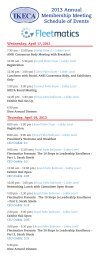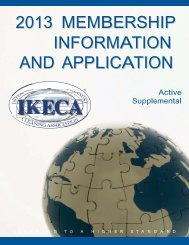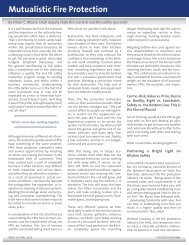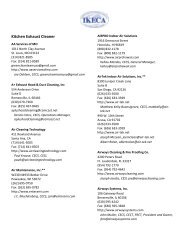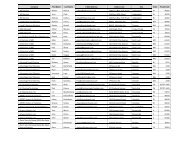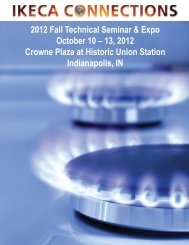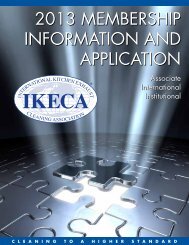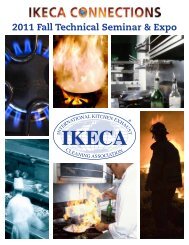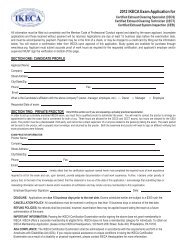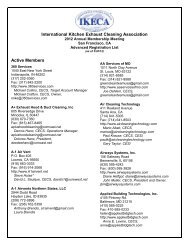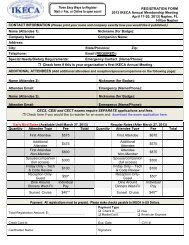IKECA Journal
IKECA Journal
IKECA Journal
You also want an ePaper? Increase the reach of your titles
YUMPU automatically turns print PDFs into web optimized ePapers that Google loves.
From the Desk of the Executive DirectorSarah Hagy, CAE<strong>IKECA</strong> Executive DirectorDear members and readers,Can you believe summer is alreadyover? As we move into the fall, withshorter and colder days, we switch ourfocus away from fun in the sun, andwe get back to business. Fall has manythings in store for <strong>IKECA</strong> —mainly, our2012 Fall Technical Seminar.This year, <strong>IKECA</strong>’s Tech heads to Indy toenjoy some hoosier hospitality! <strong>IKECA</strong> has many things in storefor members and attendees, such as a half-day session with localAHJs, hands-on vendor demos, and a robust exhibitor showing.If you are reading this during or after the Fall Tech, be sureto read the post-Tech write-up in the next member e-news.Over the next few months, <strong>IKECA</strong>’s board of directors will beputting together its strategic plan for 2013, identifying key issuesthat will have a greater impact on life safety within thecommercial kitchen exhaust industry. They will also focus on investingback into the membership, continually increasing yourreturn on investment. We look forward to sharing our planswith you once they are finalized in early January of 2013.Whether you’re a new member, a prospective member, or along-time member, don’t forget to take advantage of the manybenefits <strong>IKECA</strong> membership offers to its constituents. Whilesome are available to members only, nonmembers can orderproducts, such as grease gauges or the ANSI/<strong>IKECA</strong> C10: Standardfor Cleaning of Commercial Kitchen Exhaust Systems, or getcertified at one of the three levels we offer. For our members,please reference the following pages to learn about or remindyourself of what your <strong>IKECA</strong> membership offers you, your company,and your employees.Finally, I would like to charge each of our members with gettingmore involved with <strong>IKECA</strong>. We are a volunteer-based, nonprofitorganization, and many of our initiatives and goals are accomplishedby our volunteers. In the words of English writer JohnHeywood, many hands make light work.Please contact me directly with questions, feedback, or to getmore involved.Warmly,THE <strong>IKECA</strong> JOURNALFALL 2012 | PAGE 5
Association News TITLEMember BenefitsWhat does my membership in <strong>IKECA</strong> dofor me? What do I get for renewing eachyear? <strong>IKECA</strong> membership offers a varietyof benefits for your employees, customers,and company. Take a moment to getreacquainted.An industry voice! <strong>IKECA</strong> and its memberscontinue to provide education andprove the value of our certification withinjurisdictions all over North America.Offering complimentary fire authoritytraining in each city our meeting travelsto gets the word out about key componentsof proper cleaning, and it betterarms AHJs with the knowledge theyneed to enforce codes and standards.Setting standards for cleaning, inspection,and maintenance. <strong>IKECA</strong>, the onlynonprofit industry association, is accreditedby the American National StandardsInstitute (ANSI) to produce and publishstandards for the industry. <strong>IKECA</strong> rolledout the first of three standards in 2012:ANSI/<strong>IKECA</strong> C10: Standard for Cleaningof Commercial Kitchen Exhaust Systems,a complement to NFPA 96. The nextstandard will address inspection, andthe third will cover maintenance.Certification, certification, certification!As more and more jurisdictions are requiringcertified technicians in order toperform cleaning, <strong>IKECA</strong>’s program offerscompanies member pricing on three differentcertifications for the various levelswithin a commercial kitchen exhaustcleaning company: Certified ExhaustCleaning Technician (CECT), Certified ExhaustCleaning Specialist (CECS), and CertifiedExhaust System Inspector (CESI).<strong>IKECA</strong> also offers a designation for newfield techs, building their knowledgeof important codes and standards aswell as their confidence out in the field.Members (only) can take advantage ofthe Professional Exhaust Cleaning Technician(PECT) test, allowing the supervisorand the tech to work closely togetherto learn key concepts. Upon passing, thetech is provided with two PECT patchesto apply to his or her uniform and displayproudly.Continuing education is key to any successfulprofessional certification (thinkphysicians and teachers) and mandatoryto maintaining <strong>IKECA</strong> certification. Attendingone or both <strong>IKECA</strong> meetings, eitherthe Annual Meeting or Fall TechnicalSeminar, provides valuable industry education,covering topics that range fromfundamentals of commercial kitchen exhaustcleaning to cutting-edge technologyand changes in codes or standards.The “find a member” directory search onour website allows customers to find acompany that has made a commitmentto continuing education and certification.This invaluable benefit not only allowscustomers to find you, it also allows themto verify your affiliation with the leadingcommercial kitchen exhaust system organization,the only nonprofit, ANSI-accredited,standard-producing association.<strong>IKECA</strong>’s virtual HR desk, powered byNancye Combs of HR Enterprises. Thisonline portal gives you access to freeor discounted human resources forms,templates, policies, and procedures aswell as the latest news impacting humanresources issues. Plus, gain accessdirectly to Nancye Combs’ expertise.<strong>IKECA</strong> has endorsed CBIZ InsuranceServices as a preferred vendor for ourmembers to obtain insurance. Our representative,Richard Shaw, has a uniqueunderstanding of your business, serving<strong>IKECA</strong> for many years.Discounts on a variety of products andservices:• Access-panel stickers• Professional exhaust cleaning technician(PECT designation)—a members-onlyprogram• Inspection certificates (hood stickers)• Company brochures produced withthe <strong>IKECA</strong> logo• Grease gauges• ANSI/<strong>IKECA</strong> C10: Standard for Cleaningof Commercial Kitchen ExhaustSystems• NFPA 96 2008 or 2011• Online CEU coursesComing soon! Volunteers have been hardat work to add to the list of memberbenefits. Members will soon have access(at no additional cost) to a Kitchen ExhaustCleaning System 101 PowerPointpresentation to cover the basics of propercleaning with your local authoritieshaving jurisdiction. This is a great wayfor you to position yourself as the leadingcommercial kitchen exhaust cleaningprovider within your jurisdiction.In addition, members will soon haveaccess to a buyer’s guide, which will beupdated quarterly to provide you with ahandy reference on providers to the industry.Starting with our current associatemembers, this guide will include keycompany contacts, product lines, anddiscounts offered to <strong>IKECA</strong> members.CBIZ Offers Exciting New MemberBenefitCBIZ Insurance Services, Inc. is pleased toannounce that we can now offer <strong>IKECA</strong>members with an exclusive 401(k) programthat, for firms that qualify, offersthe following significant advantages:• Elimination of out-of-pocket administrationcosts• 51 no-load investment options managedby 6 well known fund families(T. Rowe Price, Fidelity, Federated, IN-VESCO, MFS, and Alger)• A Certified Financial Planner (CFP)is available to all participants of theplan at no additional costThis program is being offered as an exclusivemember benefit to <strong>IKECA</strong> membersas a way to save money on yourretirement plan. CBIZ will provide acomplimentary analysis and cost comparisonagainst your current plan to seewhat savings and improvements areavailable. We estimate that the typicalcost savings would be in the range of$2,500 to $3,500 per year.Contact Richard Shaw at (443) 3259-3209 (rshaw@cbiz.com) or Mike Kasecampat (301) 708-1138 (CKasecamp@cbiz.com) for more information.THE <strong>IKECA</strong> JOURNALFALL 2012 | PAGE 7
Association TITLE NewsCommittee UpdatesAssociate member committeeRichard Shaw, CPCU, ARM, chairConference committeeJack Grace, CECS, CESI, chairwill follow shortly as these projects arecompleted.The newly formed associate membercommittee has met twice to discusshow to increase ROI to Associate Members,as well as how to grow this sectionof <strong>IKECA</strong>. Some of the changes to thisyear’s Fall Technical Seminar, includingthe addition of dedicated exhibit time,was a direct result from the feedbackwe provided during our first committeemeeting this summer.Over the next year, we will be workingto increase the value of membership toassociate members while contributingvalue back to the KEC members, our customers,and the organization as a whole.Canadian chapterBill Doherty, CECS-president ofCanadian chapterI can’t believe how fast this summer hasgone by. The Canadian membership hasnow grown to 12 members. We’ve hadfour new members join in the past 12months, and we currently have membersin five provinces.The Canadian chapter was establishedin an effort to connect professional Canadiankitchen exhaust cleaning companieswho want to be leaders in theirindustry. The focus of our members is toraise a greater awareness in our industryof the importance of demanding andexpecting the entire exhaust system tobe cleaned to the metal. <strong>IKECA</strong> has beenworking diligently to recruit potentialexhaust cleaning companies, associatemembers, and AHJs who meet our eligibilityrequirements.I am also pleased to announce that twonew jurisdictions in Ontario are now recognizing<strong>IKECA</strong> certification: Chathamand the city of North Bay.Greetings from your conference committee!We have been hard at work to preparefor our upcoming conferences based onyour feedback. We have indeed listenedand learned from all the great commentarycoming from our members, AHJs,and associate members. There are someexciting changes happening, aimed atmaking the conference more inclusiveof all members and helping you get themost of your travel time. Our traditionalwelcome reception will now become theassociate member reception held on thefirst full night of conference programming.For the Fall Technical Seminar, thatwill be Thursday night, so all of our attendeeswill be able to go to and enjoythe reception. Plus our AHJ participantswill be invited to have lunch with usprior to having their training and Q&A;then, we will have our reception, so ourAHJ attendees can join us for dinner orcocktails should they be able to do so.Our content and program schedules arebased on the feedback and participationwe get from everyone; as a result, we areadding more basic education, includinghow to conduct an AHJ training, whichwe will be showing at the Fall TechnicalSeminar with our new PowerPointpresentation for our members to usein educating their local AHJs. Your participationin the conference committeeis always welcome, and we appreciateyour feedback!Certification committeeJesse Getz, CECS, chairThe certification committee has beenworking to revise the CECS test to includecontent from <strong>IKECA</strong>’s new standard:ANSI/<strong>IKECA</strong> C10: Standard forCleaning of Commercial Kitchen ExhaustSystems. Our goal is to implement thenew test as of January 2013. In additionto updating this test, we have also beenworking on additional online modulesfor members to gain CEUs. More detailsWe are currently looking for additionalvolunteers to join the committee; pleasecontact Sarah Hagy at headquarters fordetails.Marketing committeeKathy Slomer, CECS, chairOur primary area of focus this year hasbeen to complete the AHJ 101 Power-Point presentation, which we plan to rollout to members at this year’s Fall TechnicalSeminar. This is a great added benefitfor members to use as a tool in educatingthe local authorities having jurisdictionon the fundamentals of propercommercial kitchen exhaust cleaning.In addition, we have also rolled out anew monthly member e-newsletter tofurther inform our members of organizationalactivities, events, and benefits.We are always interested in additionalcontent; this vehicle is a great way torecognize an employee promotion ora milestone in your company or to promotea new product or service that willsupport life safety out in the field. Tosubmit your news, send it to information@ikeca.org.Membership committeeKevin Pearson, CECS, chair<strong>IKECA</strong>’s membership totaled 236 membercompanies and AHJs as of August31, 2012. The Committee has been hardat work to develop additional memberbenefits, like the addition of a buyer’sguide, featuring our Associate Members.We have also been focused on recruitmentover the past few months andare pleased to see prospective and newmembers attending the Fall TechnicalSeminar.We are always looking for active participantsto join our committee. Please contacta member of the headquarters teamto learn how to join our committee.PAGE 8 | FALL 2012THE <strong>IKECA</strong> JOURNAL
<strong>IKECA</strong> Organizational Overview TITLELearn more about <strong>IKECA</strong>’s Committees and BoardCertificationCommitteeResponsible for maintenanceof <strong>IKECA</strong> certificationprograms, policies andprocedures.ANSI StandardsDevelopmentConsensus BodyResponsible for creatingand maintaining the ANSIaccredited standard(s).LeadershipDevelopmentCommitteeResponsible for the selectionof candidates for theBoard of Directors as providedin the bylaws.CodesCommitteeRepresents <strong>IKECA</strong> on codesetting boards with commoninterests in advancementof kitchen exhaustsystems maintenance.Standards andPractices CommitteeResponsible for the developmentand maintenance ofpolicies and procedures.Boardof DirectorsComprised of nine votingmembers who serve threeyear terms and are elected bythe membership-at-large. Officersare elected by Directorsand serve a oneyear term.MembershipCommitteeResponsible for recruitmentand retention and memberbenefits.MarketingCommitteeResponsible for creatingawareness of KEC servicesby <strong>IKECA</strong> members to therestaurant, insurance, andfire prevention industries.ConferenceCommitteeResponsible for site selection, content developmentand sponsorship procurementfor <strong>IKECA</strong> meetings.FinanceCommitteeAssists the Board in ensuringfinancial health, assetprotection and resourceallocation.Ethics & GovernanceCommitteeResponsible for overseeingethics matters submitted inaccordance with Policiesand Procedures.THE <strong>IKECA</strong> JOURNALFALL 2012 | PAGE 9
Mutualistic TITLE Fire ProtectionBy Oliver C. Moore, Utah deputy state fire marshal and fire safety specialistIt is a well-known fact that fire marshalsand fire inspectors or the authority havingjurisdiction (AHJ) have a dilemma.That is community or public safety leadershipmay require that all businesseswithin the jurisdictional boundary beinspected no less than annually. Yet, theunderlying truth is that while the desireto get the job done is great, desiccatedbudgets, atrophied manpower, andthe general overflowing of full platesplay a substantial role in the declininginfluence a quality fire and life safetyinspection program brings to existingstandards, values, and ethics within abusiness community. Understandingthis little detail turns us to the fact thatsome businesses may or may not beinspected on a two- or three-year turnaround.If you’ll keep it quiet, we’ll keepit quiet! The [enter oversight agency here]really doesn’t need to know that little secret,do they?What a novel idea: working togetherAlthough driven by a different set of concerns,fire protection professionals (FPPs)have something of the same problem.FPPs have produced substantial salesand service opportunities by knockingon doors and kicking the bushes in theharvestable field of customers. Theyhave created such a pool of renewablebusiness it often becomes very difficultto meet inspection and service dates,and when they do, often the customer—as a result of perceived or actual economicconditions—declines the requiredfire extinguisher, fire suppression, or inspectionor cleaning of exhaust systems.Meeting this challenge alone can be tryingand somewhat overwhelming. Thetruth here is that some kitchens may notbe visited for months on end or, in somecases, years.In consideration of the risk, the fiduciaryresponsibility the FPPs have to their customers,and the requirement of law, theFPPs are helpless. This loss of revenueand the associated fading client base is aPAGE 10 | FALL 2012little secret we just don’t talk about.Restaurants, fast food enterprises, andother cooking establishments, however,have troubles of their own. The kitchenowners desire to have their kitchenspristinely cleaned and sanitized by aprofessional, so they may embrace theconfidence that everything in the kitchenwill work smoothly, function whenneeded, and keep customers safe. However,mounting regulations and statutorymandates seem to drive the bottomline into a proverbial government foodprocesser, blending a concoction mixedfor their destruction. The high cost ofwholesale foods, meats, and equipmentdoes not help the situation at all.Then, the fire protection technicianscome on their semiannual rounds. Whatcan the kitchen manager say? “We justcannot afford to update our extinguishersor service our fire suppression systemsthis year. We’ll wait until the firedepartment requires us to service thesystem. For that matter, my kitchen staffcleans the grease and grime out of ourhoods, plenums, and ducts daily. Yourservice is just too expensive and, frankly,a low economic priority in our budget.Come and see us next year.”With that being said, in today’s economicclimate, more often than not, thenow-rejected technician can do nothingbut walk away with, it seems, no optionsleft. Both he and the restaurantowner understand that without regular,planned service and cleaning this commercialkitchen’s fire risk will grow, andit multiplies every day the kitchen is inoperation. The fans will draw, the trapscollect, the filters accumulate, and theducts will bake cooking residue into aflammable blend of greasy toxins, flammablegases, and dripping ooze.These very efficient systems do theirwork daily in spite of the chef de cuisine,sous chef, saucier, grillardin, rôtisseur,pâtissier, and Bob’s son Freddy workingat one of a thousand kitchens, who, becauseof their busy positions in the kitchen,completely ignore the mountingdanger developing each day the systemmisses an inspection, service, or thoroughcleaning. Pending disaster loomsunder everyone’s consciousness.Weighing bottom-line costs against serviceresponsibilities to customers andthe pressure levied on the kitchen owneror manager forces him or her to balancethe financial survival of the kitchen withelevated and potentially disastrous risksinvolving plenums, ducts, and fan housings.This unfortunate conundrum in today’scompetitive business environmentweighs on the shoulders of all involved:owners, FPPs, fire marshals, and inspectors.Cost vs. Risk, Value vs. Price, Desirevs. Reality, Right vs. Constraint,Safety vs. the Bottom Line: This Isthe Eternal RoundSmart thinking would tell the FPP to getcozy with an AHJ and develop an ally’srelationship: to get to know one anotherand communicate with each other to thepoint of trusting each other and sharingwith each other.What a novel idea: working together!Partnering a Bright Light onKitchen SafetyIn the <strong>IKECA</strong>’s Summer 2011 issue (number32), Jim Narva, executive director ofthe National Association of State FireMarshals, addressed the fire protectionindustry. He wrote, “Being aware of therelevant codes and requirements in allthe places your business takes you, willgo a long way toward establishing trustand demonstrating good faith to the localAHJ.” Mr. Narva then followed with,“…developing familiarity with your AHJcan help in establishing trust that canresult in a higher quality and level ofcommunication.” But…why?Without knowing it, the fire protectionindustry, the AHJs, and restaurant ownershave a naturally symbiotic relationship.As partners in code and rule educa-THE <strong>IKECA</strong> JOURNAL
TITLEContinued from previous pagetion, communications relevant to publicsafety, property and customer safety,and protection of the triad of relationshipsthat includes kitchen proprietors,restaurateurs, and their employees, thisis a natural blend of people who desireto keep restaurants, kitchen staff, andcustomers safe and secure. This partneringis called “mutualistic fire protection.”But how do we do that? Who takes thefirst step; who steps off the cliff into thisunknown abyss first? When a dilemmalike this presents itself, let’s turn to naturefor the answer. Clearly, the fire serviceand the fire protection industry arein an unwitting symbiotic relationship.The restaurant industry and the fire protectionindustry are also in an unwittingsymbiotic relationship. Could that alsomean the fire marshal, owners of restaurants,and the fire protection technicianhave a symbiotic relationship as well?Wikipedia defines “symbiosis” as aclose and often long-term interactionbetween different biological specieshaving a cooperative and mutually dependentrelationship with reciprocalbenefit between unlike organisms. Hereare some examples:• Sharks and remora: demonstratecommensalism• Clown fish and sea anemone: demonstratemutualism (shelter vs. protection)© Thinkstock | Comstock• Humans and intestinal bacteria: demonstratemutualism (digestion vs.supply of nutrients)• Fire marshals and fire protection technicians:demonstrate mutualism (inspectionand expertise vs. enforcement)THE <strong>IKECA</strong> JOURNALWikipedia defines “mutualism” as relationshipsin which each individual derivesa fitness benefit, and both livingorganisms profit with respect to eachother and their natural environment.Let’s see how this works.A Simple Test for SymbiosisFire marshals:• How many inspectors do you have onstaff? (Possible answers: 1, 2, or 10.)• How often do your inspectors inspectkitchens, behind appliances, automaticfire suppression systems, and inthe ducts; pull access panels; reviewfusible link dates; and examine fanhousings, fan blades, and the rooftoparound the fan housing? (Possible answers:Every annual visit, every biannualvisit, or every third yearly visit.)• Do your inspectors know how to identifya UL 300 wet chemical systemand how to identify its functionality(does the darned thing work)? (Possibleanswer: Of course they do.)• Do your inspectors know preciselywhat to look for in a fire suppressionsystem, an exhaust system, the distancebetween access panels, manualactivation, gas valves, and hydrostaticdates for cylinders and agent tankswhen are they due? (Possible answer:What are they, and what are you talkingabout; that’s clearly not my job.)• Do they check the entire length andcondition of the ductwork? (Possibleanswer: How clean is clean?)• Do they actually climb to the roof toinspect the fan housing? What arethey looking for?• Do they look at and recognize thecondition of the roof around the fandischarge area? Do they examine thelevels of grease or oil saturation intothe roof structure?Fire protection technicians:• Semiannually, the FFP inspects kitchenswithin your jurisdiction fromfloor to roof.• They are required by code and throughgood business practices to make surethat the inspection is thorough andcomplete.• The FFP will fill out and leave with theowner an inspection and/or servicereport (with photographs) after thecompletion of every visit.• When inspecting a kitchen and it isfound that fire code, common sense,or life and fire safety violations arefound, what can the fire protectiontechnician actually do about it? Answer:Without the fire marshal, absolutelynothing!Is the result of the above test that thereis a symbiotic or protective relationshipbetween the fire marshal (FM) and theFPP? Can the FM accomplish his or hercharge without the FPP, and can the FPPaccomplish his or her charge withoutthe FM? The answer to both is yes, but towhat outcome? Both can profit and receivebenefit with respect to each otherand their natural environment.Boy, nature knows its way around a definition!For safety’s sake, reason woulddictate that fire protection techniciansare getting into restaurants every sixmonths and inspecting the kitchens andservicing the systems. A fire marshalwith wisdom and trust could rely on theconsiderable knowledge and experienceof the FPP with regard to inspections,public education, and enforcement support.This partnering is called “mutualism.”Each individual is deriving a fitnessbenefit for both and profit with respectto each other and their natural environment.Mutualistic Fire ProtectionThis new term directly references the cooperativerelationship that can be developedbetween the FPP, the fire marshal,and restaurant owners. To begin to understandmutualistic fire protection, wefind that this partnership is similar to athree-legged stool with the seat of thestool representing protection and safety.The first leg of the stool is the fire protectionindustry. This includes the kitchenFALL 2012 | PAGE 11
Mutualistic TITLE Fire ProtectionContinued from previous pageexhaust system inspectors and cleaners,the automatic fire suppression servicetechnicians, and the fire extinguisherservice industry. Together, they make upa very strong leg indeed.The second leg of the stool is the AHJ.Where the AHJ may not be able to inspectcertain kitchens effectively or annually,the AHJ does respond to citizencomplaints with vigor, enthusiasm, andextreme prejudice. They must; it’s theirnature and their duty. A partnershipwith the AHJ will show productive resultswhen a professional friendship isdeveloped and managed with honor andtrust.The third leg of the stool is the commercialkitchen owners, including their professionalassociations. With cooperativeinteraction, soon kitchen owners andmanagers will recognize that becominga partner with the FPP will help stabilizetheir relationship with risk managersand their insurance company—to understandthat rules and regulations are notintended to create unnecessary burdens,but to help insure the long life and vitalityof the restaurant and to stimulatebusiness productivity for the long term.Lastly, the unseen force that holds allthree legs and the seat together are the“glue and nail” that education, education,education, and then more educationprovide. This is the linchpin thatholds all the relationships together. Theflow of information must be ongoingand interactive throughout the networkof the partnership. Each and all partiesmust be involved and active in maintainingthe standard of protection andsafety that allows businesses to flourish.Mutualistic fire protection is an all-encompassingand driving force that canpromote success for all.The FPP now has a place to turn whenviolations and unsafe practices are apparent,when red tags are necessary. Hecalls his friend, his confidant and partner,the local fire marshal (AHJ).PAGE 12 | FALL 2012That local fire marshal then does somethingfor a trusted friend, the FPP, thatis extraordinary and quite outside his instincts,training, and his legal judgment.He simply waits.To wait is not illegal, nor is it favoritismor special treatment. However, it doesbump up against tradition, and it causesa little extra work. But what it is definitelyand most decisively doing is buildingtrust with an equal hand, protectingthe source, and locating life and firesafety violations that otherwise wouldnot have been found.His waiting is a product of not beingan expert on kitchen exhaust systems,automatic fire suppression systems, orfire extinguisher requirements. Beforehe dares to respond to this complicatedcomplaint, he must study NFPA 17A and96, the International Mechanical CodeChapter 5. He adjusts and fits this complaintinto his very busy schedule; hereviews legal steps and requirements ifenforcement might be necessary; andhe reviews city, county, and state policies,rules, and ordinances prior to theappointment.This all takes time—approximately threeto four weeks before an enlightened inspectioncan actually take place. Keep inmind that this is an annual inspection:You inspect the whole and completerestaurant, and then just happen upon,find, or bump into the listed violationsfound within your friend’s complaint.Remember: document, document, documentall of the above, and by all means,protect your source!Working as a TeamSymbiosis between business owners,fire protection technicians, and the AHJ,all working individually and together tosolve risk problems; to mitigate risk; andto influence its probability and impactthrough communication, education, andsupport, may be a long-term proposition.However, it is a wise and importantundertaking. Partnering would help toestablish a predictable and serviceablepreventive maintenance and inspectionalert and mitigation program.With the communication, care, and planningit provides, the transfer and sharingof the risk as a fire protection teambecomes the goal. Working togetherto reduce the impact of the risk and toshelter its consequences when a disasterdoes happen should be the goal of everyparticipant. When the owner, contractor,and fire marshal partner in such a way asto qualify the risk mitigation effort and,with assurance, reduce any inevitableliability cost or enforcement effect, thesynergistic effect can only produce successfuland low-impact outcomes.How does this happen? If a fire shouldoccur in a kitchen, because of the effortsof the mutualistic fire protection coalition,liability charges, depositions, courtappearances, subrogations, and stressmay all be somewhat diffused throughthe work and efforts of the coalition.Mutualistic fire protection is a new termwith well-established practices of collaboration,planning, cooperation, andcommunication. When kitchen owners,FPPs, and the AHJ partner together andlubricate their relationship with trust,this well-oiled relationship will insurethe reduction of risk and that safety andprotection are certain for commercialkitchens and the associated restaurantindustry. In today’s economic environment,it can be no other way.THE <strong>IKECA</strong> JOURNAL
Continued from previous pageOliver C. MooreDeputy State Fire Marshal, Fire PreventionSpecialistUtah State Fire Marshal’s OfficeOliver C. Moore retired as a Battalion Chiefwith an illustrious and honorable thirtysixyear career in the fire service. ChiefMoore has served as both volunteer andfull paid firefighter, emergency medicaltechnician, engineer/driver, station captain,and fire ground & field commander,hazardous materials technician, fire operationstraining officer, medical trainingofficer, administrative officer, public informationofficer, fire cause and arson investigator,public fire educator and juvenilefire-setter intervention evaluator. ChiefMoore was assigned as Fire Marshal andlead fire cause investigator for West ValleyCity, the second largest city in Utah up tothe time of his retirement. As Fire Marshalhe also served in the Homeland SecurityDivision Volunteer Management and Responsearena. He is an authority in a varietyof community preparedness initiativesincluding, fire safety, public education andmarketing, citizen corp./fire corp. councils,CERT program coordinator, and communitypreparedness planner.Chief Moore currently serves the UtahState Fire Marshal in the role of Fire PreventionSpecialist with a focus on, life andfire safety inspections of state buildingsand schools, commerce and trade licensingcoordinator with an emphasis on fireprotection concern licensing and techniciancertifications, to include the fire extinguisherservice, automatic fire suppressionsystems service and kitchen exhaustsystems inspection and cleaning serviceindustries. He has developed training curriculumsfor fire protection initiatives andon-line testing for these subjects. His developmentand oversight of the new “ReducedCigarette Ignition Propensity andFirefighter Protection” program for theState Fire Marshal is remarkable.Please feel free to contact him at:omoore@utah.gov or 801-284-6349THE <strong>IKECA</strong> JOURNALFALL 2012 | PAGE 13
Questions from MembersBy Kevin Pearson, CECS“…I don’t understand why we have theCECT and the CECS. The CECT seems awfullyexpensive when it is so close in scope to theCECS. …what is the point in having both?”This is a great question, and it allows foran opportunity to point out the benefitsin having the CECT (Certified ExhaustCleaning Technician), along with ourCECS (Certified Exhaust Cleaning Specialist)and CESI (Certified Exhaust SystemInspector) levels of certification.First, it’s important to understand thatall levels of <strong>IKECA</strong>’s certification programare in line with nationally accepted standardsfor continuing professional education.<strong>IKECA</strong> certification is quite differentfrom all other industry programs.Currently, <strong>IKECA</strong> certification is the onlycertification that is maintained by a nonprofit(giving it a much better chance oflongevity than any other), and it is theonly certification that requires and tracksstandardized CEUs (continuing educationunits). This requires that certified memberskeep pace with industry standardsand changes. <strong>IKECA</strong> certification is not alifetime certification.But why have the CECT at all with ourother two levels of certification already inplace? Here are some of the key reasonsthe CECT was developed and has beenmaintained:• Initially, CECT was developed for a specificmunicipality, where the local AHJswere compelled to require a meaningfuland reasonable certification for all kitchenexhaust cleaners operating within thejurisdiction. Although the municipalitycalled the certification by another name,the program was adopted by the <strong>IKECA</strong>as the CECT. With the CECT in place, wedo not need to write a separate programfor each municipality that would like tohave the <strong>IKECA</strong> handle the total certificationprocess and CEU tracking—kindof a one-size-fits-all for AHJs. The resultingbenefit to AHJs partnering with the<strong>IKECA</strong> is multifaceted.• The CECT program also adds benefitsfor <strong>IKECA</strong> member companies. One benefitis that they can elevate techniciansfrom being TQ, trained and qualified, orPECT to being TQC, trained, qualified,and certified, designated by the CECT,without having to meet all of the rigidrequirements and expenses of the CECSlevel of certification.• Another benefit to members is they canaffordably have certified people on everyjob if they wish to comply with theANSI/<strong>IKECA</strong> C10: Standard for Cleaningof Commercial Exhaust Systems andNFPA 96 requirements to have TQCtechnicians on every job with a reducedexpense (compared to obtaining CECSstaff for each crew). Remember thatthese two standards require certifiedindividuals on every job. The CECT programoffers an affordable way to makesure that each <strong>IKECA</strong> member companycan be compliant with code requirementsthat <strong>IKECA</strong> members eitherwrote or helped to write.• This level of certification also offers alayer of protection for member companyowners. If a company owner whois compliant with the above-cited coderequirements loses a CECT certified employeeto a competitor or to start hisContinued on next pagePAGE 16 | FALL 2012THE <strong>IKECA</strong> JOURNAL
Fire Authority Training, Southern CaliforniaAdapted from “Tales of the Greaser,” submitted by Don Pfleiderer, EnviromaticThank you to all the area fire inspectorsattending the exhaust system seminarin Oceanside, California! What a nicearea, and it was at least 20 degrees coolerthan what I left in Minneapolis!I was joined by fellow <strong>IKECA</strong> memberMario Abab from Air Cleaning Technology,and I invited a nonmember to learna little about how <strong>IKECA</strong> members providetraining to AHJs. Also in attendancewas the deputy fire marshal from SanDiego who has since requested a halfdayseminar for his jurisdiction in thenear future.I asked the inspectors in attendance toprovide a show of hands to signify if theyhad ever been involved in having to extinguishor investigate a grease exhaustfire; several hands were raised. Withthe firsthand experience in the room,the pictures and protocols for proper inspectionsthat I addressed were right onpoint. Good questions were asked, and afew of them deserve more attention inthis write-up.The first question was about rooftopareas and inspections. The AHJs statedthat they really had no way to inspectthe rooftop areas in their routine inspections.I showed them areas of concernduring the seminar; we looked at picturesthat showed many jobs that usedshortcuts. It appeared that proper cleaningwas done when looking down fromthe roof, but the bottom half to a quarter—wherethe largest fire dangers arelocated—is often missed, leaving thick,old buildup. I noted that even thoughrooftop inspections might not be quiteas important as the lower sections of theduct and the horizontal runs in the ceilingareas they should be done becausefires starting on the roof and/or in thefan areas can go uncontrolled withoutfire suppression systems in those areas.As for the lower sections above the hood,I reminded the audience that proper inspectionpictures should include a clearview looking up from the hood showingall four sides, including the back of theupper filter rail if possible.Another question raised was about howfar the inspector really needs to look ifthere is a hood sticker. I let them knowthat the hood sticker only means someonewas there and that something wascleaned; it does not guarantee propercleaning in accordance with NFPA 96 orANSI/<strong>IKECA</strong> C10: Standard for Cleaningof Commercial Exhaust Systems. Onceyou are familiar with local kitchen exhaustcleaning (KEC) companies, thatmay be an indication of the job quality,but only after many previous completevisual inspections of their work shouldthis be a factor. Even then, I noted thatspot checks are necessary. Accordingto NFPA 96, the minimum standard requiresremoval of all grease (combustiblematerial). I shared that in a majorityof the jobs I inspect around the country,this minimum standard is not necessarilyattained, no matter what the hoodsticker states. I pointed out how badthings have gotten in a suburb in myarea that used to have one of the toughestand best KEC inspection programs inthe country. Without these on-the-jobinspections, almost every single horizontalduct I have inspected in the past twoyears has not been cleaned.The moral of the story in this presentationwas that a fire inspector must havethe filters removed upon arrival at thelocation to look at the inside of the entiresystem during inspection. If the inspectorcannot climb up into the hood,taking digital pictures with a camera usinga monopod with a swivel head caneasily show most areas.Finally, I recommended that the groupconsider setting up an inexpensive licensingprogram to monitor KEC vendors.With the advent of digital cameras,once a fire inspector has his or her ownbaseline pictures of a system, the inspectorcan request pictures from the KEC tomake sure it is conforming to applicablestandards. Not only do the inspectorsneed to be reviewing these pictures, Ialso shared that they must be preparedto make the KEC go back and take additionalpictures if there is anything unclearabout what was documented.In summary, simply looking to make surethere is a hood sticker is not adequatefor any proper fire inspection program.A complete visual inspection is requiredto help prevent grease fires. Tools suchas a digital camera with a monopod willhelp these inspectors tremendously instreamlining their inspection process.PAGE 18 | FALL 2012THE <strong>IKECA</strong> JOURNAL
New Certifications - Congratulations to those whoachieved their certification this year!BCCSBoston Certified Cleaning SpecialistCECSCertified Exhaust Cleaning Specialist• Michael CarawayKitchen Klean, Inc.• Scott LandryNoble Hood & Duct Cleaning Co.• Erik PetersonTri State Hood and Duct, LLC• Francis J. Buckley, Jr.BMCA, Inc. dba Air Duct Services• Savoun PoCochrane Ventilation, Inc.• Francisco LugoAir Duct Services• Kun WangDa Tong Cleaning Service• Alexander FuscoOmni Pro, Inc• Joseph RamirezShannon Diversified, Inc.• Ken WoodruffPhoenix Industrial Cleaning, Inc.• Donald DavisNelbud Services Group, Inc.• Sean C. WeirNRL Fire Protection Services, Inc.• Gregory PucciStanley Steemer Great Lakes, Inc.• Randy ConfortiPrecision Kleen, Inc.• Mr. James FoleyThe Steam Guy• Deborah BarnettDunnwell, LLC• Billy YorkBlast Masters, Inc.• Duane BurnettMr Hood Cleaning Service, LLC• Matthew Kelly-BuonsignoreAirTek Indoor Air Solutions, Inc.• Robert AllenEnviromatic Corporation of America• Larry GwinGwin’s Steam Cleaning, Inc.• Brien PichaEnviromatic Corporation of America• Gregory SmithEnviromatic Corporation of America• Richard Busto ToschiaddiCrankin Solutions, LLC• Christopher Robin DouglasInterior Maintenance Company, Inc.• David FelderC & D Hood and Duct Service• Page NorsworthyTidewater Pressure Washing, LLC• Barry MuellerR and J Vent-A-Clean• M. Andrew WatsonEnviromatic Corporation of America• Rafael CostasRestaurant Environmental TechnologiesCECTCertified Exhaust Cleaning Technician• Anthony HindleNelbud Services Group, Inc.• Jason BeachellWestern State Hood Cleaning• Alfonso Iniguez Mercado360 CLEANING SERVICES• Ken C BrandomR and K Maintenance• Donald MacCallumOptional Cleaning Ideas• Jorge MedinaMJ Exhaust Hood & Cleaning Service• Hiram RiveraNelbud Services Group, Inc.CESICertified Exhaust System Inspector• Scott JustisNelbud Services Group, Inc.• Joe HoustonEnviromatic Corporation of America• Ken WoodruffPhoenix Industrial Cleaning, Inc.• M. Andrew WatsonEnviromatic Corporation of AmericaPECTProfessional Exhaust Cleaning Technician(designation)• Jose AguirianoNelbud Services Group, Inc.• Alexis GonzalezNelbud Services Group, Inc.• David LindnerNelbud Services Group, Inc.• Renan Lopez-SanchezNelbud Services Group, Inc.• Flavio PerezNelbud Services Group, Inc.• Louis MenizeA-1 Airvents Northern States, LLC• Stephen PowellA-1 Airvents Northern States, LLCTHE <strong>IKECA</strong> JOURNALFALL 2012 | PAGE 19
AHJ CornerBy Wayne P. Tomassi, CECS, CESIHoodz of the Hudson ValleyA great way for exhaust cleaning companiesto expand their business is to developa networking referral relationshipwith fire suppression companies, restaurantsuppliers, hood installers, food distributors,and others associated with therestaurant business. It would seem thatthe best referrals could or should comefrom your local AHJ, but politics, fear ofcollusion, or local government rules, inmany cases, impede and often actuallyprevent this. I have experience in somecommunities where the AHJ is not evenallowed to accept my business card.The fact is that if the AHJ could give outsuch a list, it might even improve thequality of exhaust cleaning!We all know that NFPA 96 is a standardthat can only be enforced in communitieswhere the local government has approvedregulations for enforcement ofsome or all parts of the standard. As anexample, many communities will adoptthe IMC for the fabrication or installationof a hood system, the IFC for suppression,and NFPA 96 chapter 11 for themaintenance and cleaning of the system.It is sad that only after a major firethat has resulted in casualties, often firemen,are some of these regulations formallyadopted and the local AHJ givenstrong authority for their enforcement.These regulations often include sometype of testing, screening, and certificationof exhaust cleaning companies.In the northeast, Boston initiated sucha program, which was later adopted bythe state. New York City, Atlantic City,and others across the nation are followingthis example.So, say you’re an AHJ and you have noticedthat some exhaust cleaning companiesin your jurisdiction do a great job,some are just okay, and some are simplyunacceptable. When doing a fire inspection,you often get asked for recommendationsfor exhaust cleaning companies,but you feel uncomfortable providingany. Or say you own an exhaust cleaningcompany that is insured, properly trainsits teams, follows procedures, and doesa quality job. You’re losing business toPAGE 20 | FALL 2012companies able to undercut your pricingbecause they do not have the insurancecosts or don’t do a quality job. In theseexamples, neither person has had successin getting a regulation passed toclean up the exhaust cleaning business,but they strongly desire to do so.The hurricanes and resulting floodingin the Northeast last year gave me theanswer to this problem. Local buildinginspectors had to go into flood-ravagedcommunities and condemn buildingswith flood damage. Understand that differentbuilding inspectors had differentreasons for condemning buildings basedon their own interpretation of variousbuilding codes. They were often challengedbecause they were inconsistent.They were only successful when theycould point to a fair, consistent, writtenpolicy for determining what buildingscould be condemned based on a list ofguidelines within the policy.Does the policy have to be a local communityregulation? Absolutely not! Andherein lies the solution: The policy issimply a fair, consistent, definable approachthat can be implemented easilyand without any prejudice.Any AHJ can write a policy by which itcan maintain a list of exhaust cleaningcompanies that meet the conditionsof this policy to hand out to commercialkitchen businesses in their area ofauthority. The process is simple: If yourcompany meets the guidelines of thewritten policy, your company’s namecan be on the list. If it does not, it is noton the list. The list is maintained in alphabeticalorder and includes companynames, addresses, a contact name,phone numbers, and websites and/ore-mail addresses. By writing a fair policyand maintaining such a list, an AHJ canfreely give out the list without any fearof reprisals. A well-written policy canraise the bar for exhaust cleaning in theAHJ’s jurisdiction.What should be included in the policy?How do you write one?A quick search of the web for the BostonFire Department in Massachusetts orother communities that have developedregulations is a great way to find a listof ideas to include in your policy. Yourpolicy can include the following:• Proof of a legally formed or charteredbusiness according to your state lawswith a valid tax EIN.• A minimal insurance requirement: $2million in general liability is typical.• A minimal bonding requirement.• Specific requirements for informationon the hood label to be affixed tohoods after cleaning:o Date of serviceo Defined frequency of inspectiono Month of next inspectiono Indication of NFPA 96 complianceor noncompliance, possibly withdifferent colors to identify such.• Specific requirements for the exhaustclean after-action report, includinghow to file a copy of the report.• Specific reasons that would result inthe company being removed from thelist and the warning procedure:o Insurance expirationo Reports not provided per policyo AHJ inspector’s finding of poorquality in last exhaust clean performedo Continued complaints from businesses.• Other criteria as you desire, as long asthey are fair, consistent, and specificallydefinable.Nowhere in the above suggestions isthere any mention of any type of certificationrequirements. Requiring anytype of certification implies some typeof training, testing, and intensive record-keepingon companies or even individualswithin companies. Most AHJsdo not have the manpower to develop,implement, and maintain such a certificationprogram, so don’t even try. Rememberthat the purpose of developingTHE <strong>IKECA</strong> JOURNAL
AHJ Corner (continued)a policy is to define requirements for anyexhaust cleaning company to be placedon a list that the AHJ could hand out if itis requested by a kitchen representative.The list simply eliminates those fly-bynightindividuals who are not insured,not bonded, and possibly not even a legalcompany.The fact is that, per NFPA 96, with the exceptionof seasonal businesses, all kitchensshould have their exhaust systemsinspected at least twice a year. If commercialkitchens are abiding by this standard,most communities have enough ofthem to support a few kitchen exhaustcleaning businesses. Simply said, there isenough work to go around! As an AHJ, ifyou have a policy and if you have a list ofthose companies that meet the requirementsof your policy, you are helping yourcommunity. The contacts on your listcan be said to be great exhaust cleaningcompanies offering good service, performance,and quality at competitive ratesbecause the rules are the same for all.Wayne Tomassi, CECS, CESI, is the Owner/President of HOODZ of the Hudson Valley,with 2 years in the industry, and over 30years as Facilities Engineering/Managementof HVAC/exhaust systems for thesemiconductor industry. He is a part timesafety consultant and instructs NYS AHJson NFPA-96 for their CEUs. .2013Annual Membership MeetingApril 17-20 at the Hilton Naples in Naples, FLFall Technical Seminar & ExpoOctober 9-12 at the Hyatt Regency Phoenix in Phoenix, AZFuture Meeting DatesMark your calendars now for <strong>IKECA</strong>’s future meetings!20142014 Annual Meeting (Celebrating 25 Years!)April 23-26 at the The Golden NuggetLas Vegas, NVPLEASE NOTE: If you rely on attending <strong>IKECA</strong>meetings or conferences to obtain the required CEUs,attendance is tracked, and certificates of attendanceissued based on actual attendance.*Acceptable organization conferences include:NADCA, ASHRAE, NAFA, NFPA, NAFED, RFMA, NASFM.For all others, please contact <strong>IKECA</strong> to confirmeligibility. Continuing Education is valued at 0.1 CEUper one hour of content.**Acceptable in-house training includes: OSHA SafetyTraining; OSHA 8 hour and 10 hour training;Manufacturer-specific training; Red Cross. For allothers, please contact <strong>IKECA</strong> to confirm eligibility.Continuing Education is valued at 0.1 CEU per onehour of content.
Welcome New <strong>IKECA</strong> MembersActive North AmericaGrease Stop, LLCReading, PAAirTek Indoor Air Solutions, Inc.Azusa, CAThe Steam GuyThunder Bay, Ontario, CanadaStateFire DC SpecialtiesSalt Lake City, UTCrankin Solutions, LLCSanta Ana, CAPrecision Kleen, Inc.Euclid, OHStanley Steemer Great Lakes, Inc.Byron Center, MIGwin’s Steam Cleaning, Inc.Dayton, OHRestaurant Environmental TechnologiesCoto Laurel, Puerto RicoInternationalLifa Air, Ltd.Helsinki, FinlandSteamatic AustraliaBraeside, AustraliaEPSCO, LLCJebel Ali, DubaiProfessionals SARLBeirut, LebanonAssociateTaskMaster KECCartersville, GAFleetMaticsWellesley Hills, MAKECSupplies.comDenver, PASupplementalEnviromatic Corporation of AmericaColumbus, OHNelbud Services Group IncLas Vegas, NVEnviromatic Corporation of AmericaOcala, FLHas Your Information Changed?Member contacts can easily changethe information on their membershiprecord by logging in to MembersOnly on www.ikeca.org, or contactassociation headquarters.<strong>IKECA</strong>100 North 20th Street, Suite 400Philadelphia, PA 19103(215) 320-3876information@ikeca.orgPAGE 22 | FALL 2012THE <strong>IKECA</strong> JOURNAL
<strong>IKECA</strong> Board of Directors 2012-2013Submit an Article for the<strong>IKECA</strong> <strong>Journal</strong>Contribute to the conversation in the commercialkitchen exhaust cleaning industry– write an article for the next issue of the<strong>IKECA</strong> <strong>Journal</strong>. Articles should be on currentsubjects of interest to those in cleaning andinspection, including contractors, fire authorities,insurance providers, facility managersand owner/operators.* Your perspective on today’s industry topics* Share your story with an innovation or newdevice or procedure* Your personal experience that offers lessonslearned* Best practices on maintenance or repair* Frequently asked questions that you wantto answer* Personnel or staffing tips that you’ve learnedDetails• View <strong>IKECA</strong>’s full Article Submission Guidelinesfor all details.• Email complete articles toinformation@ikeca.org• Articles should be between 750 and 2,000words (between 1 ½ to 4 typed pages)• Charts, tables and photos are welcome,subject to editorial approval• Include a short biography of the author (50words)• Articles must be educational and informativein nature, and must not be advertisementsfor specific good or services. All aresubject to review, approval and editingbefore publication.Share your IdeasNot sure about writing an article?Our professional staff will help you “polish”your article. Don’t let the thought that “I’mnot a writer” stop you from sharing yourideas or perspective.Need more incentive?Earn CEUs!Need continuing education credits to maintainyour certification?Earn 0.3 CEU for submitting an article forpublication in the <strong>IKECA</strong> <strong>Journal</strong>.PRESIDENTJack Grace, CECS, CESI (2014)Western Commercial ServicesLas Vegas, NVjack@westerncommercial.netTREASURERJesse Getz, CECS (2014)Getz Fire Equipment Co.Peoria, ILJesseGetz@GetzFire.comVICE PRESIDENTKathy Slomer, CECS (2013)Kool Kleen Inc.Murrysville, PAkathykoolkleen@aol.comIMMEDIATE PAST PRESIDENTRobert D. Schuler, CECS, CESI (2013)Bentley Resources, Inc.Sarasota, FLrschuler@tampabay.rr.comSECRETARYRandall Rauth, CECS (2014)Hood Cleaning, Inc.Waukesha, WIrandy@hoodcleaninginc.comDIRECTORSBill Doherty, CECS, CESI (2013)Pressure Kleen Services Company, Inc.Toronto, OntarioCanadabilldoherty@pressurekleen.comKevin Pearson, CECS (2013)Grime Stoppers, IncBlack Eagle, MTkevin@grimestoppersinc.netArmando Alcala, CECS (2015)Protectco, Inc.Mount Prospect, ILarmando@protectcousa.comFrank Mitarotonda, CECS, CESI (2015)Chief Fire PreventionMount Vernon, NYfrankm@chieffire.comGrant Mogford, CECS, CESI (2015)Flue Steam, Inc.Culver City, CAgrant@fluesteam.comYOUR Ad HereHow many potential customers might you reach through anadvertisement in the <strong>IKECA</strong> <strong>Journal</strong>?Advertise in the <strong>IKECA</strong> <strong>Journal</strong>Published – two times per yearCirculation – 500+ <strong>IKECA</strong> member and industry companies.Published online and accessible by <strong>IKECA</strong> membersEditorial includes Feature Stories, How To Articles, Educationalopportunities and much more!Contact information@ikeca.org for a 2012 rate sheet andadvertising specifications.Questions? Call <strong>IKECA</strong> at 215-320-3876 oremail information@ikeca.org.THE <strong>IKECA</strong> JOURNALFALL 2012 | PAGE 23
100 North 20th StreetSuite 400Philadelphia, PA 19103215-320-3876www.ikeca.org



